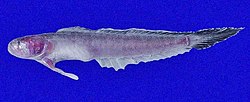| Akko brevis | |
|---|---|
 | |
| Scientific classification | |
| Domain: | Eukaryota |
| Kingdom: | Animalia |
| Phylum: | Chordata |
| Class: | Actinopterygii |
| Order: | Gobiiformes |
| Family: | Gobiidae |
| Genus: | Akko |
| Species: | A. brevis |
| Binomial name | |
| Akko brevis (Günther, 1864) | |
 | |
| Synonyms | |
| |
Akko brevis, the dark-tail specter-goby, is a species of gobies native to the eastern central Pacific from El Salvador to Panama. It is found in black muddy bottoms of estuaries and mangroves. [2] [1]
